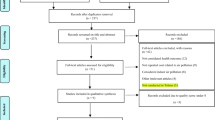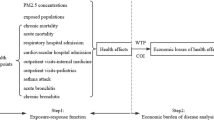Abstract.
In recent years, there has been growing interest in cost-effectiveness analysis for environmental regulations using quality-adjusted life years as the measure of effectiveness. This paper explores the implications of the QALY approach for measuring the impacts of air pollution regulations, with an example using the U.S. Environmental Protection Agency’s Heavy Duty Engine/Diesel Fuel regulations. The paper also examines the issues surrounding the potential use of QALY measures in cost-benefit analysis for air pollution regulations. Key findings are that, compared with a cost-benefit approach, the QALY framework gives more weight to reductions in incidence of chronic disease relative to reductions in premature mortality risk, especially when the mortality risk reductions occur in older populations. In addition, use of monetized QALYs in cost-benefit analysis is not recommended, due to fundamental differences in the theoretical grounding of the different measures. However, application of monetized QALYs based on age-specific willingness to pay (WTP) for mortality risk reductions gives very similar results to typical cost-benefit analysis for mortality risk reductions, as opposed to using values for QALYs based on non-age specific WTP. The paper concludes that in cases where mortality provide the majority of a regulation’s impacts, QALY based cost-effectiveness analysis and WTP based cost-benefit analysis may not differ in their conclusions. However, in cases where morbidity or non-health outcomes are significant, cost-effectiveness and cost-benefit analysis may result in different evaulations of the efficiency of the regulation.
Similar content being viewed by others
References
Abbey D.E., Petersen F., Mills P.K. and Beeson W.L. (1993). ‘Long-Term Ambient Concentrations of Total Suspended Particulates, Ozone, and Sulfur Dioxide and Respiratory Symptoms in a Nonsmoking Population’. Archives of Environmental Health 48: 33–46
Abbey D.E., Hwang B.L., Burchette R.J., Vancuren T. and Mills P.K. (1995). ‘Estimated Long-Term Ambient Concentrations of PM(10) and Development of Respiratory Symptoms in a Nonsmoking Population’. Archives of Environmental Health 50: 139–152
Abt Associates (2000) ‘Final Heavy-Duty Engine/Diesel Fuel Rule: Air Quality Estimation, Selected Health and Welfare Benefits Methods and Benefit Analysis Results’, Prepared for the Office of Air Quality Planning and Standards, US Environmental Protection Agency, RTP, NC, Available at http://www.epa.gov/ttn/ecas/regdata/tsdhddv8.pdf Accessed May 22, 2002.
Adams P. F., G. E. Hendershot and M. A. Marano (1999), ‘Current estimates from the National Health Interview Survey, 1996’, National Center for Health Statistics, Vital Health Statistics 10(200).
Alberini, A., M. Cropper, A. Krupnick and N. B. Simon (2002), ‘Does the Value of a Statistical Life Vary with Age and Health Status?’ Evidence from the United States and Canada, Resources for the Future Discussion Paper 02–19. April.
Anderson, R. N. and P. B. de Turk (2002), United States Life Tables (1999), National Vital Statistics Reports, vol 50, no 6, Hyattsville, Maryland: National Center for Health Statistics.
Bala M.V. and Zarkin G.A. (2000). ‘Are QALYs an Appropriate Measure for Valuing Morbidity in Acute Diseases?’. Health Economics 9: 177–180
Bell C.M., Chapman R.H., Stone P.W., Sandberg E.A. and Neumann P.J. (2001). ‘An off-the-Shelf Help List: A Comprehensive Catalog of Preference Scores from Published Cost-Utility Analyses’. Medical Decision Making 21: 288–294
Bleichrodt H., Wakker P.P. and Johannesson M. (1996). ‘Characterizing QALYs by Risk Neutrality’. Journal of Risk and Uncertainty 15: 107–114
Carrothers, T. J., J. S. Evans and J. D. Graham (2002), ‘The Lifesaving Benefits of Enhanced Air Quality’, Risk Analysis (in press).
Clinton W.J (1993). ‘Executive Order 12866 Regulatory Planning and Review’. Federal Register 58: 51734–51744
Cohen J.T., Hammitt J.K. and Levy J.I. (2003). ‘Fuels for Urban Transit Buses: A Cost Effectiveness Analysis’. Environmental Science and Technology 37: 1477–1484
Cutler D.M. and Richardson E. (1997). ‘Measuring the Health of the US Population’. Brookings Papers Microeconomics 1997: 217–271
Melse J.M., Lebret E., Kramers P.G.N. and Hollander A.E.M. (1999). ‘An Aggregate Public Health Indicator to Represent the Impact of Multiple Environmental Exposures’. Epidemiology 10: 606–617
Doctor J.N., Bleichrodt H., Miyamoto J., Temkin N.R. and Dikmen S. (2004). ‘A New and More Robust Test of QALYs’. Journal of Health Economics 23: 353–367
Freeman A.M., Hammitt J.K. and De Civita P. (2002). ‘On Quality Adjusted Life Years (QALYs) and Evironmental/Consumer Safety Valuation’. AERE Newsletter 22(1): 7–12
Garber A.M. and Phelps C.E. (1997). ‘Economic Foundations of Cost-Effectiveness Analysis’.. Journal of Health Economics 16: 1–31
(1996). Cost-Effectiveness in Health and Medicine. New York, Oxford
Goldberg M.S., Burnett R.T., Tamblyn R., Ernst P., Flegel K., Brook J., Bonvalot Y., Singh R., Valois M., Vincent R. and Bailar J.C. (2001). ‘Identification of Persons with Cardiorespiratory Conditions Who are at Risk of Dying from the Acute Effects of Ambient Air Particles’. Environmental Health Perspectives 109: 487–494
Hammitt J.K. (2002). ‘QALYs versus WTP’. Risk Analysis 22(5): 985–1001
Heinzerling, L. and F. Ackerman (2002), ‘Pricing the Priceless: Cost-Benefit Analysis of Environmental Protection’, Georgetown University Law Center, Georgetown Environmental Law and Policy Institute Publication.
Hoyert D.L., Arias E., Smith B.L., Murphy S.L. and Kochanek K.D. (2001). ‘Deaths: Final data for 1999’, National Vital Statistics Reports, vol 49, no 8. National Center for Health Statistics, Hyattsville, Maryland
Johnson, F. R. and K. Lievense (2000), ‘Stated-Preference Indirect Utility and Quality-Adjusted Life Years’, Report prepared for Health Canada, Triangle Economic Research Working Paper No. T-004, June. (Accessed at http://www.ter.com/ter/Papers/Technical/T-0004.pdf on April 1, 2004).
Jones-Lee M.W. (1989). The Economics of Safety and Physical Risk. Basil Blackwell, Oxford
Jones-Lee, M. W., G. Loomes, D. O’Reilly and P. R. Phillips (1993), ‘The Value of Preventing Non-fatal Road Injuries: Findings of a Willingness-to-Pay National Sample Survey’, TRY Working Paper, WP SRC2.
Kaiser J. (2003). ‘How Much are Human Lives and Health Worth?’. Science 299: 1836–1837
Kerridge R.K., Glasziou P.P. and Hillman K.M. (1995). ‘The use of “Quality-Adjusted Life Years” (QALYs) to Evaluate Treatment in Intensive Care’. Anaesth Intensive Care 23: 322–331
Krewski, D., R. T. Burnett, M. S. Goldbert, K. Hoover, J. Siemiatycki, M. Jerrett, M. Abrahamowicz and W. H. White (2000), ‘Reanalysis of the Harvard Six Cities Study and the American Cancer Society Study of Particulate Air Pollution and Mortality’, Special Report to the Health Effects Institute, Cambridge, MA, July 2000.
Krupnick A.J. and Cropper M.L. (1992). ‘The Effect of Information on Health Risk Valuations’. Journal of Risk and Uncertainty 5(2): 29–48
Krupnick A., Cropper M., Alberini A., Simon N., O’Brien B., Goeree R. and Heintzelman M. (2002). ‘Age, Health and the Willingness to Pay for Mortality Risk Reductions: A Contingent Valuation Study of Ontario Residents’. Journal of Risk and Uncertainty 24: 161–186
Kunzli N., Kaiser R., Medina S., Studnicka M., Chanel O., Filliger P., Herry M., Puybonnieux-Texier V., Quenel P., Schneider J., Seethaler R., Vergnaud J.-C., Sommer H. and Horak F. (2000). ‘Public-health Impact of Outdoor and Traffic-related Air Pollution: A European Assessment’. The Lancet 356: 795–801
Kunzli N., Medina S., Kaiser R., Quenel P., Studnicka M. and Horak F. (2001). ‘Assessment of Deaths Attributable to Air Pollution: Should We Use Risk Estimates based␣on Time Series or on Cohort Studies?’. American Journal of Epidemiology 153: 1050–1055
Levy J.I., Hammitt J.K., Yanagisawa Y. and Spengler J.D. (1999). ‘Development of a New Damage Function Model for Power Plants: Methodology and Applications’. Environmental Science and Technology 33: 4364–4372
(2006). ‘Valuing Health for Regulatory Cost-Effectiveness Analysis’, Report of the Committee to Evaluate Measures of Health Benefits for Environmental, Health and Safety Regulation. Institute of Medicine. The National Academies Press, Washington, D.C
NationalAcademiesof Science (NAS) and National Research Council (2002). Estimating the Public Health Benefits of Proposed Air Pollution Regulations. The National Academies Press, Washington, DC
Pliskin J.S., Shepard D.S. and Weinstein M.C. (1980). ‘Utility Functions for Life Years and Health Status’. Operations Research 28: 206–224
Pope D.A., Burnett R.T., Thun M.J., Cale E.E., Krewski D., Ito K. and Thurston G.D. (2002). ‘Lung Cancer, Cardiopulmonary Mortality, and Long-Term Exposure to Fine Particulate Air Pollution’. Journal of the American Medical Association 287: 1132–1141
Schmidt C.W. (2003). ‘Subjective Science: Environmental Cost-benefit Analysis’. Environmental Health Perspectives 111: A530–A532
Schwartz J. (1993). ‘Particulate Air Pollution and Chronic Respiratory Disease’. Environmental Research 62: 7–13
Singer P., McKie J., Kuhse H., Richardson J. and Harris J. (1995). ‘Double Jeopardy and the Use of QALYs in Health Care Allocation’. Journal of Medical Ethics 21: 144–157
Suwa T.J., Hogg C., Quinlan K.B., Ohgami A., Vincent R. and Eeden S.F. (2002). ‘Particulate Air Pollution Induces Progression of Atherosclerosis’.. Journal of the American College of Cardiology 39: 935–942
Teng T.O., Adams M.E., Pliskin J.S., Safran D.G., Siegel J.E., Weinstein M.C. and Graham J.D. (1995). ‘Five Hundred Life-Saving Interventions and Their Cost- Effectiveness’. Risk Analysis 15: 369–390
Tsevat J., Dawson N.V., Wu A.W., Lynn J., Soukup J.R., Cook E.F., Vidaillet H. and Phillips R.S. (1998). ‘Health Values of Hospitalized Patients 80 Years or Older’. Journal of the American Medical Association 279: 371–375
US Environmental Protection Agency (1996), ‘Air Quality Criteria for Particulate Matter’, National Center for Environmental Assessment, Office of Research and Development, Research Triangle Park, vol II. NC; US EPA report no EPA/600/P-99/002bF.
US Environmental Protection Agency, (1999), ‘The Benefits and Costs of the Clean Air Act, 1990–2010’, Prepared for US Congress by US EPA, Office of Air and Radiation/Office of Policy Analysis and Review, Washington, DC, November, US EPA report no. EPA-410-R-99-001.
US Environmental Protection Agency (2000), ‘Regulatory Impact Analysis: Heavy-Duty Engine and Vehicle Standards and Highway Diesel Fuel Sulfur Control Requirements’, Prepared by: Office of Air and Radiation, Available at http://www.epa.gov/otaq/ diesel.htm. Accessed April 16, 2002.
US Environmental Protection Agency Science Advisory Board (1999), ‘The Clean Air Act Amendments (CAAA) Section 812 Prospective Study of Costs and Benefits (1999): Advisory by the Health and Ecological Effects Subcommittee on Initial Assessments of Health and Ecological Effects: Part 2’, EPA-SAB-COUNCIL-ADV-00–001, October.
US Environmental Protection Agency Science Advisory Board (2001), ‘Review of the Draft Analytical Plan for EPA’s Second Prospective Analysis – Benefits and Costs of the Clean Air Act 1990–2020’, An Advisory by a Special Panel of the Advisory Council on Clean Air Compliance Analysis, EPA-SAB-COUNCIL-ADV-01-004, September.
US Office of Management and Budget (2001), ‘Valuing the Health Benefits of Enhanced Air Quality’, Office of Information and Regulatory Affairs, Comments Prepared for Public Meeting of the Committee on Estimating the Health Benefits of Proposed Air Pollution Regulations, National Research Council/National Academy of Sciences, October 8.
US Office of Management and Budget (2003), ‘Circular A-4: Regulatory Analysis’. US Government Printing Office.
Viscusi, W. K., W. A. Magat and J. Huber (1991), ‘Pricing Environmental Health Risks: Survey Assessments of Risk-Risk and Risk-Dollar Trade-Offs for Chronic Bronchitis’, Journal of Environmental Economics and Management 21, 32–51.
Author information
Authors and Affiliations
Corresponding author
Rights and permissions
About this article
Cite this article
Hubbell, B.J. Implementing QALYs in the Analysis of Air Pollution Regulations. Environ Resource Econ 34, 365–384 (2006). https://doi.org/10.1007/s10640-004-7437-1
Published:
Issue Date:
DOI: https://doi.org/10.1007/s10640-004-7437-1




